News and Analysis regarding scarce coins, coin markets, and the coin collecting community #217
A Weekly CoinWeek Column by Greg Reynolds ………..
On Thursday, April 24, at a convention center near Chicago, Heritage will offer “The Riverboat Collection” of private and territorial gold coins, as part of the official auction of the CSNS Convention. This is one of the most comprehensive collections of pioneer gold coins ever to be auctioned. Though I am not so sure about the quality, as I have not seen most of the coins and have not yet heard much about the characteristics of the individual pieces, the quantity of rarities and the depth of this collection are astonishing.
The unnamed collector who consigned “The Riverboat Collection” is alive, purchased these coins at “various times over a few decades,”and last added to this collection around 2006, according to Todd Imhof, executive vice president of Heritage. It thus seems that all the coins are ‘fresh,’ as they have not been publicly offered in more than five years. All of his private and territorial gold coins are in this upcoming auction. He started collecting coins when he was a kid and he does collect other coins.
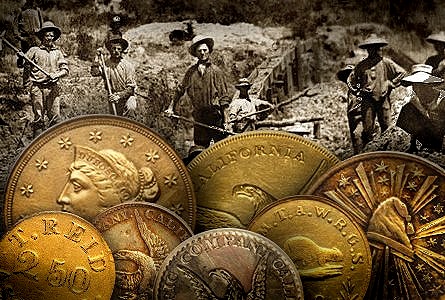 I would be startled if his other coins are as important as the coins in “The Riverboat Collection,” which is full of important rarities, some of which have great historical significance. There are sixty-three pieces in this consignment, sixty-two pioneer gold coins and an 1836 U.S. One Dollar Gold pattern. The most valuable piece is one of the two finest known Kellogg $50 gold pieces.
I would be startled if his other coins are as important as the coins in “The Riverboat Collection,” which is full of important rarities, some of which have great historical significance. There are sixty-three pieces in this consignment, sixty-two pioneer gold coins and an 1836 U.S. One Dollar Gold pattern. The most valuable piece is one of the two finest known Kellogg $50 gold pieces.
Private or territorial gold coins may generally be called ‘pioneer’ gold coins, as the ‘pioneer’ term encompasses various private, semi-private and government issues. Further,the word pioneer does not just refer to “someone who is one of the first people to move to and live in a new area,” it also refers to “a person or group that originates or helps open up a new line of thought or activity,” states the online Merriam-Webster dictionary. Pioneer gold coins were new and different in their own respective eras.
Most pioneer gold coins were issued by private firms, as there were too few government issued gold coins available in some regions to satisfy the needs for coinage in commerce. The U.S. Branch Mint in San Francisco did not open until 1854 and, at various times after opening, did not produce sufficient coinage for commerce in the region, which was dynamic and thrilling.
For anybody who enjoys reflecting upon “the expansion of America, the rapid development of the West, and the amazing experiences of gold explorers and other pioneers, these gold coins have fantastic historical significance,” asserts Charlie Browne. “The California Gold Rush was one of the most exciting times in the history of the United States. Pioneer coins reflect the pains and gains of the settlers in The West. It is unbelievable that there were so many firms making coins and that quite a few survive for people to collect now,” Browne declares.
Charlie has been a professional numismatist for more than thirty-five years and has, during multiple periods, spent more than one hundred months grading coins for the PCGS. Browne has also graded many famous rarities for coin dealers and for collectors.
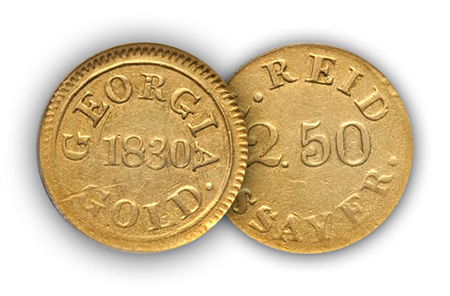 Charlie has examined many pioneer gold coins and looks forward to viewing “The Riverboat Collection,” which includes coins from the South as well. Before the California Gold Rush, there was a Southern Gold Rush, from around 1828 to the mid 1830s.
Charlie has examined many pioneer gold coins and looks forward to viewing “The Riverboat Collection,” which includes coins from the South as well. Before the California Gold Rush, there was a Southern Gold Rush, from around 1828 to the mid 1830s.
Among private gold coins associated with the the Southern Gold Rush, the coins of Templeton Reid are the rarest. These were minted in Georgia in 1830. I discussed Templeton Reid and his coins at length in an article last year. “The Riverboat Collection” contains a Templeton Reid $2½ coin, which is PCGS graded “AU-50.” Fewer than twenty-five are known.
There were also western, pioneer gold coins outside of California. The group of Mormon gold coins in “The Riverboat Collection” is exemplary. As the major varieties require considerable explanation, I am not listing them here.
The many Wass Molitor varieties, too, are confusing, without a long explanation. There is a very important group of Wass Molitor coins in this sale. “The Riverboat Collection” Wass Molitor $50 gold piece is NGC graded “MS-63.” I have seen it in the past. I just do not remember where, at the moment. Also, there are noteworthy 1849 Norris (California) $5 pieces in this collection.
The Bechtler coins of North Carolina, the Moffat-Humbert-“U.S. Assay” pieces of San Francisco, and the Clark Gruber coins of Colorado are the least rare pioneer gold issues. Although “The Riverboat Collection” contains noteworthy groups of these, this collection will be best remembered for rarer and more mysterious pioneer gold issues of the West. The Moffat-Humbert-“U.S. Assay” story, though, is central to the history of pioneer gold in the West. This organization melted and recoined many of the gold coins issued by others in the San Francisco area.
I. Moffat-Humbert-“U.S. Assay”
The San Francisco pioneer pieces struck by the Moffat firm, including United States Assay coins struck under the authority of U.S. Assayer Augustus Humbert and including those coin struck without the involvement of John Moffat himself, are the most often traded and collected pioneer gold coins. Most major coin auctions include at least a couple of these of some sort. Hundreds survive.
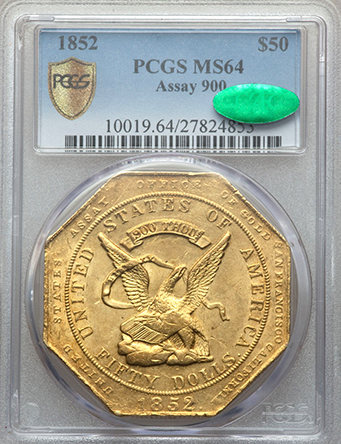 The Moffat name is found on $5 gold coins dated 1849 and 1850, on $10 coins dated 1849 and 1852, plus, curiously, on $20 gold coins dated 1853. In the “Riverboat Collection,” there are two 1852 Moffat $10 pieces of the ‘Close Date’ variety; one is PCGS graded “AU-50” and the other is NGC graded “MS-60.” The Riverboat 1852 Moffat $10 piece with a ‘Wide Date’ is NGC graded “MS-61.”
The Moffat name is found on $5 gold coins dated 1849 and 1850, on $10 coins dated 1849 and 1852, plus, curiously, on $20 gold coins dated 1853. In the “Riverboat Collection,” there are two 1852 Moffat $10 pieces of the ‘Close Date’ variety; one is PCGS graded “AU-50” and the other is NGC graded “MS-60.” The Riverboat 1852 Moffat $10 piece with a ‘Wide Date’ is NGC graded “MS-61.”
In 1851, the Moffat firm entered into a contract with the U.S. Treasury Dept. to make $50 gold coins, under the direction or at least the authority of Augustus Humbert, who had been appointed the U.S. Assayer for the region. On Feb. 11, 1852, “Moffat & Co. received authority to issue [$10 and $20 coins] at the Assay Office,” stated Edgar Adams in a scholarly article in the AJN (New York: ANS, 1912). The U.S. “Assay Office was created as a temporary provision which would take the place of a [U.S.] Government Mint,” Adams emphasized. The Moffat operation formally became, or was tightly integrated with, the “U.S. Assay Office” and Humbert was the U.S. Assayer. For simplicity, I include Curtis, Perry & Ward as part of the Moffat operation or firm, broadly defined.
On more than one occasion in 1851, the Moffat firm sent a letter to the U.S. Secretary of the Treasury to request permission for the Moffat-“U.S. Assay Office” operation to mint coins in denominations of less than $50. Permission was denied at least twice before it was granted late in 1851.
In correspondence that is reprinted in Adam’s work, the impression is given that the Moffat operation and the U.S. Assay Office were the same entity, though U.S. Assayer Augustus Humbert had specific responsibilities. The coins issued by this Moffat-“U.S. Assay Office” entity did extensively circulate as money, yet were termed “ingots” for legal and/or bureaucratic reasons.
Although PCGS graded “AU-58” and NGC graded “MS-63” 1851 Humbert $50 pieces in this collection will bring substantial sums, these are not especially rare, as type coins. The 1852/1 “Humbert” $20 gold piece in “The Riverboat Collection” was formerly in the Eliasberg Collection and is NGC graded “MS-64.” It is among the most highly certified of Moffat-Humbert-“U.S. Assay” coins.
In 1852, before the Moffat-Humbert-“Assay Office” entity was federally authorized to issue $10 and $20 gold pieces, the Moffat firm, presumably without the U.S. Assayer, issued 1852 dated $10 pieces with the Moffat name because $10 gold coins were urgently demanded by people in the San Francisco area. Indeed, on Jan. 7, 1852, the Moffat firm made an interesting position clear:
“There is nothing in the law establishing the United States Assay Office [which was integrated with Moffat & Co.], nor is there anything in our contract with or bond to the Secretary of the Treasury, which precludes or prohibits this issue of the coin of Moffat & Co.” By the middle of January, Moffat 1852 dated $10 coins were circulating (Adams, 1912, p. 33). In early Feb. 1852, the U.S. Treasury Department, perhaps upon learning of the new Moffat $10 gold coins, authorized Moffat, as an entity integrated with the U.S. Assay Office, to mint $10 and $20 gold coins that featured the name of the nation, United States of America.
Curiously, Moffat himself left the Moffat firm soon afterwards. The other three partners (Curtis, Perry & Ward) took charge. Adams theorized that coins with the words “United States Assay Office of Gold” spelled out were minted by Curtis, Perry & Ward, after John Moffat left the organization. My impression is that the Moffat operation remained very much the same, after Moffat himself retired. There are several plausible reasons as to why Humbert’s name may have no longer appeared on coin issues, after some point in 1852.
The reasons for the use of the Moffat name on $20 gold pieces dated 1853 are a little complicated and are best addressed in a future discussion. The 1853 Moffat $20 piece in “The Riverboat Collection” is NGC graded “MS-62” and is one of the highest certified of this issue.
There are too many, highly certified U.S. Assay gold pieces of 1852 and 1853 in “The Riverboat Collection” to list here. There are also a couple of highly certified, 1852 U.S. Assay $50 pieces.
Although some varieties of Moffat-Humbert-“U.S. Assay” pieces are rare, the basic types are not rare. Collecting these ‘by type’ is practical and not difficult for those who can afford them. A respectable type set that is reasonably complete could be assembled in less than two years. Collecting relatively rare types of pioneer gold coins is a whole different matter.
One of the most distinctive aspects of “The Riverboat Collection” is the presence of some of the rarer and mysterious privately issued gold coins. These are not practical to collect in a short amount of time. Even a collector with $15 million to spend would have trouble completing a type set of pioneer gold issues that are generally accepted as legitimate. Many of the key pieces are extremely rare and/or are not accessible. It is the presence of some of the rarer types that makes “The Riverboat Collection” so interesting.
II. Grading Pioneer Gold Coins
I feel morally compelled to put forth a warning regarding the grading of private and territorial gold coins. These tend to be graded much more liberally than U.S. gold coins of the same time periods. Indeed, my examinations of PCGS and NGC graded pioneer gold coins over a period of more than twenty years suggests at least some graders at both services have a tendency to assign numerical grades to some private or territorial gold coins that have serious problems.
In some (not all) cases, a pioneer gold coin with problems may receive a numerical grade, while a corresponding federal gold coin that was minted in the same year and has about the same problems may be determined to be non-gradable. Of course, not all pioneer gold coins have a chance of ever receiving numerical grades from the PCGS or the NGC; some are just too ‘screwed up.’
In the now defunct PCGS magazine, “Rare Coin Market Report,” the fact that private or territorial gold coins are sometimes graded more liberally was stated in every issue that I saw. In the Feb. 2008 issue (on p. 29) and in the May 2008 issue (on p. 35), there is a list of reasons as to why the PCGS may find specific coins to be “ungradeable,” including altered surfaces, repairs, artificial toning and environmental damage. Following that list, it is formally stated in this PCGS publication, “Some allowances are made for ultra rarities, colonials and territorial gold coins, in which there are some instances when ‘net grading’ is used by PCGS as a service to the [collecting] community.”
Charlie Browne worked as a PCGS grader, at various times, during four different decades. “Back in the 1980s at PCGS, grading the pioneer and territorial gold was very similar to grading federal gold pieces. As years went by, we [graders] started to take everything into consideration when looking at private or territorial gold, including severe handling in commerce in the West, unusual alloys, and impurities in the metal. We considered that many pioneer gold coins were struck in primitive ways, sometimes with poorly prepared dies. Some were saved in harmful environments,” Charlie explains.
“Today, PCGS graders do not grade them as strictly as they grade federal gold coins. They let problems slide because of the unusual nature of the coins,” Browne emphasizes. “An issue that would be major for a federal gold coin from the mid 19th century is sometimes minor for a private or territorial gold coin.” Pioneer coins that have been blatantly tooled, however, still do not receive numerical grades, Charlie notes.
In my view, with which Browne may or may not agree, collectors of especially rare pioneer gold coins should not take the certified grades too seriously. Collectors should seek the advice of a grading expert and/or an expert in private and territorial gold coins. In my opinion, when collecting pioneer gold coins, the emphasis should be on the history and physical rarity of the coins.
III. Pacific Company
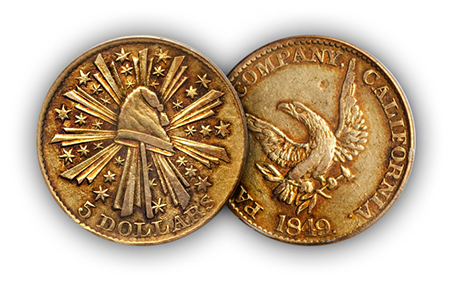 The two Pacific Company pieces in this sale are among the most fascinating coins in “The Riverboat Collection” and are of extraordinary importance to specialists in pioneer gold coins of the 19th century. As far as I know, all Pacific Company pieces are dated 1849.
The two Pacific Company pieces in this sale are among the most fascinating coins in “The Riverboat Collection” and are of extraordinary importance to specialists in pioneer gold coins of the 19th century. As far as I know, all Pacific Company pieces are dated 1849.
The Heritage cataloguer suggests that three Pacific Company $1 gold coins survive. One that has been “holed” as not been publicly seen in decades. “The Riverboat Collection” $1 piece is clearly the best of the three listed. I did see it, a long time ago. At an earlier time, this piece was in the collection of Virgil Brand, who assembled one of the all-time greatest collections of coins.
Charlie Browne agrees that collectors of Pacific Company coins and other infrequently seen pioneer issues should focus on the rarity rather than on numerical grades. “These pieces are amazingly rare; they are true classic rarities. With just three Pacific Company Dollars existing, I would rather have one of these than a MS-64 grade Moffat coin,” Browne asserts.
Of the four Pacific Company $5 pieces that probably exist, one is in the Smithsonian and two have not been seen in a long time. “The Riverboat Collection” contains the Garrett family coin, which is PCGS graded “AU-58.” In the Garrett Collection sale of March 1980, the firm of Bowers & Ruddy auctioned this very same coin for $180,000. For collectors seeking many types of pioneer gold coins, the Garrett pedigreed Pacific Company $5 coin would be a tremendous prize.
IV. Dubosq
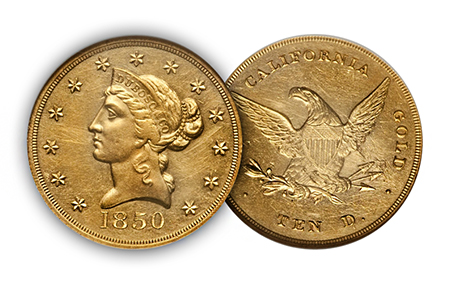 All known Dubosq $5 and $10 gold coins are dated 1850. Edgar Adams is credited with unearthing a notice in the Alta California weekly newspaper, issue of May 31, 1849 (at the bottom of p. 2, second column) that states, “We learn also, that Mr. Theodore Dubosq, a jeweller from Philadelphia, who recently arrived in the Grey Eagle [ship], has brought with him the necessary machinery for striking private coin.”
All known Dubosq $5 and $10 gold coins are dated 1850. Edgar Adams is credited with unearthing a notice in the Alta California weekly newspaper, issue of May 31, 1849 (at the bottom of p. 2, second column) that states, “We learn also, that Mr. Theodore Dubosq, a jeweller from Philadelphia, who recently arrived in the Grey Eagle [ship], has brought with him the necessary machinery for striking private coin.”
The PCGS has graded four Dubosq $10 gold coins, as VG-08, VF-20, EF-40, and AU-50, respectively. Evidently, the NGC has graded two; one is NGC graded “MS-61“ and the present Riverboat Collection Dubosq $10 coin is NGC graded “MS-60.”
As for Dubosq $5 gold pieces, Breen listed three in his encyclopedia in 1988, two of which are in museums. The third is listed then as having been last seen in 1951 and as having been “plugged.” So, collectors seeking a Dubosq gold coin may never have the opportunity to acquire a $5 piece and the $10 pieces appear very infrequently.
The Heritage cataloguer lists eight, two of which are in museums. A Dubosq $10 gold coin has not been auctioned since 2002. I saw the Amon Carter piece in the late 1980s, years after the Carter sale in 1984. I remember being intrigued by it.
IV. Baldwin
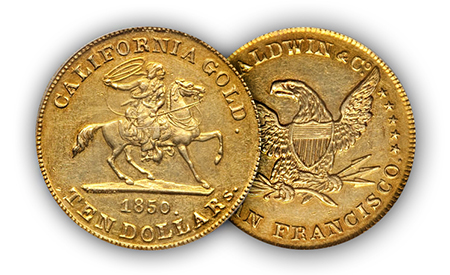 Baldwin coins are not not nearly as rare as Dubosq or Pacific Company pieces. Even so, these are extremely rare. The Baldwin firm issued $5 and $10 pieces dated 1850. Additionally, this firm issued $10 and $20 pieces dated 1851.
Baldwin coins are not not nearly as rare as Dubosq or Pacific Company pieces. Even so, these are extremely rare. The Baldwin firm issued $5 and $10 pieces dated 1850. Additionally, this firm issued $10 and $20 pieces dated 1851.
The 1850 Baldwin $5 piece and the 1850 Baldwin $10 piece in “The Riverboat Collection”are each PCGS graded “MS-61.” I have seen a few Baldwin 1850 $10 coins and will devote a future discussion to this issue.
The 1850 Baldwin $10 pieces are particularly popular with collectors, as these feature a representation of a man on a horse. They are very different from federal U.S. coins.
The Baldwin 1851 $10 issue is somewhat similar to a U.S. Liberty Head Eagle ($10 gold coin). The Baldwin $5 gold coins are very similar to the Liberty head Half Eagles that were issued by U.S. Mints during the same time period.
An 1852 Baldwin $20 coin is one of the prizes of “The Riverboat Collection”! It is one of four known and was formerly in the epic Garrett family collection. Perhaps the Garrett family had the all-time greatest collection of private and territorial gold coins.
V. Schultz
The Schultz firm provided services for mints and banks in San Francisco. In early 1851, this firm produced its own coins, perhaps just $5 gold pieces. In 1988, Breen stated that ten to twelve are “known.” The Heritage cataloguer now lists ten survivors. Two of these ten are in “The Riverboat Collection”! One is graded “MS-62” and, the other, “AU-53.” These are sharp representatives of a very mysterious issue. Why is the Shultz name mis-spelled or not clear on all known Schultz $5 gold pieces?
VI. Oregon
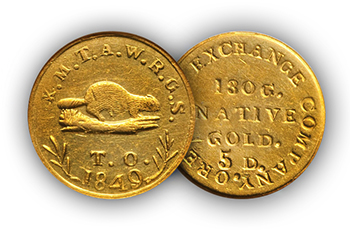 The story of the Oregon $5 and $10 gold coins is intriguing and cannot be fairly summarized here. All these are dated 1849. “The Riverboat Collection” Oregon $5 gold coin has incredible detail for a coin of this issue. It is NGC graded “MS-62” and is the highest certified.
The story of the Oregon $5 and $10 gold coins is intriguing and cannot be fairly summarized here. All these are dated 1849. “The Riverboat Collection” Oregon $5 gold coin has incredible detail for a coin of this issue. It is NGC graded “MS-62” and is the highest certified.
The PCGS has graded twenty-five and the NGC has graded twenty-one Oregon $5 gold pieces. The PCGS and the NGC together have probably graded about thirty different coins and there are probably at least seven that are utterly ungradable. Moreover, I figure that there are at least three that are gradable, yet have never been submitted to the PCGS or the NGC. Overall, I estimate that forty to forty-five survive. As to whether this coin is the finest known, I will not comment.
“I saw several Oregon pioneer gold coins when I graded for PCGS,” Charlie Browne reflects. “I love the coins. The design is great. The crudeness of the pieces adds to their mystique. These represent a new frontier, barely inhabited, dangerous, adventurous. These are really neat coins, pieces of true primitive coin art, very cool. The images suggest that these in ‘The Riverboat Collection’ might be really nice representatives of Oregon issues,” though Charlie has not yet seen these two.
“The Riverboat Collection” Oregon $10 coin is PCGS graded “AU-55” and is the top ranked piece in Heritage’s roster of fourteen. Back in 1988, researcher Breen said that fourteen to sixteen are “known.”
I have seen this Oregon $10 coin. I attended “The Orlando Sale” of Aug. 10, 1992 by Superior Galleries. This coin was PCGS graded AU-50, not AU-55, at the time. Even so, I wrote in my catalogue that “it is nice for the grade” and that it has much original luster. I hope that it has not been modified in the interim. For a crudely made pioneer gold coin, this piece is excellent. The price realized of $36,300 was strong in 1992.
Market levels and demand structures for coins were then much different from current realities. This coin has a retail value in excess of $275,000 now. Several of the coins in “The Riverboat Collection” will realize prices above $200,000 each. Given the rarity and historical significance of some such pieces, six figure prices are understandable. Some of the relatively less rare pioneer coins may be obtained for much more modest prices in other auctions.
©2014 Greg Reynolds




